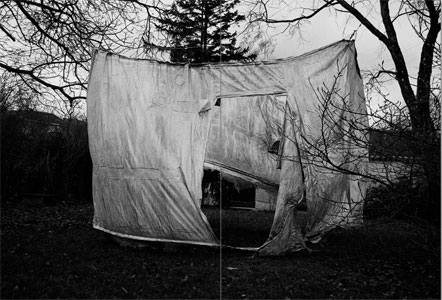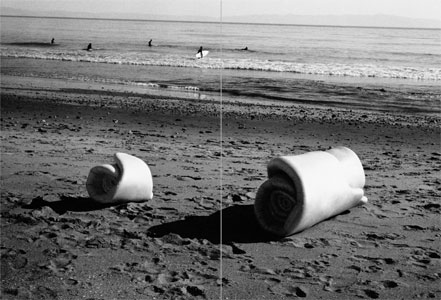‘… We slowly loosen the rubber layering, the skin, tugging the yesterday into today..’
(.. Wir lösen langsam die Kautschukschichten, die Haut, und ziehen das Gestern ins Heute.)
Before coming across a recent taz article these days I hadn’t heard about the work of the swiss architect Heidi Bucher. The article on her work, entitled ‘Die Haut der Erinnerung’ (The skin of remembrance), brought my attention to an interesting artist focusing on ‘skinnings’ in combination with the usage of the sensitive, but as well seductive and ambivalent material latex.
| Heidi Bucher, who died of cancer in 1993, left behind a work which showed a remarkable access towards the main topic of her work: space, in deriving and preserving a kind of sensitive ‘memory blueprint’ of her environment and its embedded traces. In her early work she had been work with ‘clothing skins’ in a form of ‘painting installations’, as well as performance. Later she became known for taking large imprints of entire spaces done by latex. One of her last big projects was the ‘skinning’ of the famous Villa Bleuler, which had a lifely cultural history and today hosts the Swiss Institut for Art Research (link). Her first retrospective was done by the migros museum in 2004. Sorrily most of the information available is only accessible in german, thus I think she is still very much an artist to be discovered. |

|
| …. Famous for her soft sculptures and latex molds of architectural fragments or whole spaces in the 1970s and 80s, Bucher’s work suffered an eclipse in the 1990s. This publication is the first to offer a complete overview of the surprising production of this artist, who has been compared in her approach to Gordon Matta-Clark and Rachel Whiteread. (images and short synopsis from the retrospective monograph >>link) | video link from migros |
…. Heidi Bucher began to embalm clothes, blankets, cushions and other objects with “rubber milkâ€, and to assemble them into simple arrangements. The objects all pertained to the private sphere. Her work became a hunt for clues to her proper existence, an approach that was shared by a number of artists at the time. Bucher began to examine her own life like a historian. Her layerings are thus closely linked to the “clothing-reliefsâ€, and were initiated in the same year, 1974. From 1974 until 1977, Bucher lived and worked in a former butcher’s shop. Her atelier was situated on the spacious lower floor, which she called “Borgâ€. This was where the first spatial layerings took place. With the Herrenzimmer (“Men’s Roomâ€, 1977/1978) Bucher returned to her childhood home, the 19th century Winterthur villa. She coated the wood panelling of the walls and floors with viscous latex. Once this had hardened, she tore off the textile-latex skins, and embalmed them with mother-of-pearl pigment. As she rubbed in the pigment, the skins acquired a shimmering, iridescent surface, and also a new “inner life .. (read on)
migros museum press text (german)
pdf info of the Swiss Institute for Research Art (german)
DVD ‘spaces are shells, are skins’
restauration research pdf – part on Bucher’s work page 19-23 (german)

